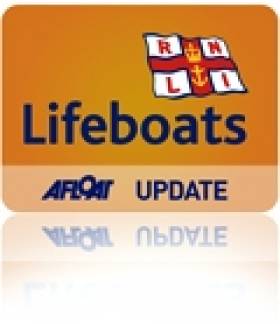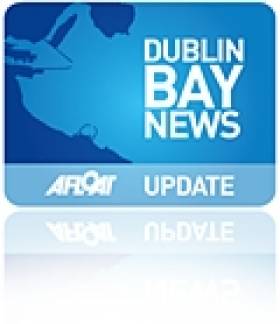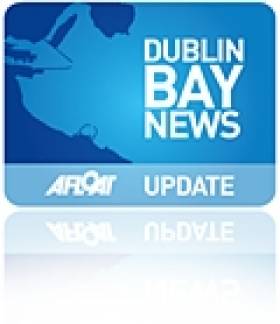Displaying items by tag: INSS
#inss – Last week, Sailing on Saturday featured the Royal Cork Yacht Club, the oldest in the world, as it comfortably donned the mantle of the ISA/Mitsubishi Motors Sailing Club of the Year 2015. This morning, we find ourselves involved with what may well be the newest sailing club in the world, the Irish National Sailing Club. It is certainly, thanks to being inaugurated nearly three months after Youghal SC was founded on 28th October 2014, the newest in Ireland. W M Nixon tries to explain it all as he finds himself in the world of Irish sailing's most complete dynamo.
Alistair Rumball is a Life Member of the Awkward Squad. Cage-rattling and pot-stirring are second nature to him. But it's not because of experiencing an unhappy childhood. On the contrary, while growing up in Malahide, his boyhood summers were bliss. He and his brother Arthur had as much sailing as they could want, fitted in between part-time jobs raising pocket-money with a morning picking potatoes at Dermot Dickie's farm along the Broadmeadow Estuary, followed by an afternoon of sailing the sea with the sun always shining, and then maybe an evening of club racing followed by the easy camaraderie among kids who are comfortable with boats.
It was an idyllic maritime environment which, over the years, has produced some of Ireland's top racing and cruising sailors. But while the young Rumball was no slouch on the race-course, the strongest feeling he had about sailing was the sheer fun of it all, the totally absorbing wonder of being in a boat and hauling on ropes to make sails change shape and help you along your chosen course over the always interesting sea.
Although he graduated from Trinity College Dublin as an engineer, he increasingly had this almost evangelical attitude to spreading the good news about the fun of sailing. And while he has something of a reputation – to say the least - for being confrontational, it's central to his contradictory character that he's an extremely good teacher. If somebody shows the slightest genuine enthusiasm about wanting to learn to sail, Alistair Rumball has been prepared to go to endless lengths to teach him or her to do so, and to do so with enjoyment.
Underlying that, we find the first of his gripes about the modern sailing scene. He reckons that it has become far too serious. Don't think for a moment, though, that he believes in a frivolous approach to boats and sailing. He's deadly serious about having everything just right as regards safety and function.
But once that's sorted, then he firmly believes that you should go out and enjoy it. He waxes lyrical about moments of sheer sailing ecstasy he has enjoyed in a wide variety of boats in many sailing locations worldwide. And whatever he may have formally set out to be in a professional career, his working life has been spent in and around boats, getting people introduced to boats and out afloat, sometimes on an almost industrial scale.
Time was when sailing skills were something you acquired by a sort of osmosis through family tradition, club opportunities, and friendship examples. That's mostly how Rumball himself learned to handle a sailing boat. But he seems to have this almost messianic zeal to teach people to sail, and he became convinced that the future lay in more structured training with a proper syllabus.
Having taken a long hard look at the population distribution of the Greater Dublin area and where they might best get afloat in worthwhile numbers, in 1978 he acquired the assets of a moribund organisation, the Dun Laoghaire Sailing School, and soon found himself giving his first lessons to two pupils using a fibreglass-clinker Darragh 14 knockabout sailing dinghy which they'd launched from the public slipway in the Coal Harbour in Dun Laoghaire. The long journey had started towards an organisation whose activities today today include top-of-the-line race training in 1720s in winning mode:
The majestic granite harbour of Dun Laoghaire was a cold place in 1978 for any young enthusiasts trying to set up an independent sailing school on a commercial basis. For the powers that be, sailing was something to be learned through family and clubs under the Junior Training Programme of the Irish Yachting Association. If you were a young person or adult from a non-sailing background but keen to learn, unless you'd an obliging and patient friend from within the sailing establishment, the expectation was that you'd take yourself off to somewhere far away like the Glenans Ireland bases in Baltimore and Bere Island and Clew Bay, and eventually reappear after a decent interval with enough experience, newfound ability and contacts to make the grade in the Dublin Bay sailing scene, where the very thought of a raw in-harbour sailing school for outsiders seemed distasteful to the establishment.
Yet hidden away in the southwest corner of Dun Laoghaire harbour, here was this gadfly of the sailing scene, Can–do Alistair with his rough and ready sailing school enthusiastically recruiting pupils anywhere and everywhere, and taking them afloat in boats which may not have been in the most pristine condition, and certainly set sails which would not be winners on the race course, yet they were safe and able, and so were he and his instructors.
Over the years, an entire cohort of people, mainly from Dublin but also from all over Ireland with a useful smattering of pupils from abroad, came to boats and sailing thanks to this wild-haired character whose love of his demanding work shone through everything he did.
Gradually the fleet expanded, and so too did the "Rumball Group's" activities, even though the very limited availability of premises on the Dun Laoghaire waterfront meant that every little square foot they had always seemed to serve at least three different purposes. But they were getting there, they opened a retail outlet in the town to sell boat gear and equipment which became Viking Marine, the school promoted itself to being the Irish National Sailing School, and they were well settled in place, using every inch of space on the ground floor of the interesting little building on the southwest corner of the harbour which used to be the Nautical College.

The man and his machines – Alistair Rumball and his chariot outside the Irish National Sailing School's HQ in Dun Laoghaire. Photo: W M Nixon
Centuries ago, seafaring education was given a significant role in Irish life in the late 1700s, the 1800s, and the early 1900s with the old Marine School a fine building on the south quays in Dublin. But its premises were re-allocated for development purposes and the school itself had its final home in Clontarf before being absorbed only as a vague memory into what is now Mount Temple Comprehensive school.
These days, the marine education focus has moved to Cork with the fabulous new National Maritime College in Ringaskiddy, but for that low period in Irish maritime life in the mid 20th century, one of the few keepers of the flame was Captain Tom Walsh who operated the little Nautical College in this fairly inconspicuous Office of Public Works building now hidden away behind the Dun Laoghaire Motor Yacht Club.
Captain Tom Walsh in teaching mode in 1957 in the INSS building when it was the Nautical College.

The 110ft barquentine which Jack Tyrrell designed for Captain Tom Walsh's Nautical College in 1954 in the hope that it would inspire the building of an Irish Tall Ship
It was the gallant Captain Walsh who in 1954 commissioned Jack Tyrrell of Arklow to design a 110ft sailing ship – a barquentine – to be Ireland's very own tall ship, our first sailing training vessel. God bless the good captain, but he was convinced that if he could just get someone in Government to see these inspiring plans, then such a ship would be on the way.
You can imagine just how far such a visionary idea travelled in the deadly dull Ireland of the 1950s. Far from getting a proper training ship built, Captain Walsh had enough trouble keeping his college in being. Yet he was a gentleman and enthusiast to the end, and after retirement he augmented his pension by testing compasses in yachts, which I remember well as he did it for me with a little cruiser in 1981. The only mutually convenient time it could be done was on a Saturday evening, and I'd to get the boat from Howth to Dun Laoghaire to do it, but the actual swinging of the compass by Tom Walsh was such a pleasant and educational experience that any thoughts of being at some Saturday night party were entirely banished.
So when you go into the main premises of the Irish National Sailing School today, it's natural to remember Captain Tom Walsh, and I like to think that he would thoroughly approve of the old building's current usage, for Alistair Rumball and his team are mighty busy during what must sometimes be an 18-hour day, and just this week – before the sailing season is really fully under way – Monday was typical, with 185 schoolkids bussed down from Maynooth for a day's coaching afloat, followed by all sorts of gatherings including a committee meeting of the newly-formed Irish National Sailing Club.
Space is so constrained that a floating dinghy park has to be used to store the smaller craft. Photo: W M Nixon
Thanks to the special INSS fendering devised by Arthur Rumball, this 35-year-old Squib has survived many seasons of tough teaching in good order. Photo: W M Nixon
To economise on space, the Squibs berthed here, with the INSS building in the background, are double-moored. Photo: W M Nixon
Of which more anon, for this bare outline gives only a hint of the INSS's complex programme. The Rumball theme is that you have to keep operations and facilities flexible to cope with fluctuating demand, for at the height of the season the school is operating a fleet of 200 boats ranging from kayaks through sailing dinghies of increasing size, then on into keelboats of which some well-fendered Squibs are the workhorses while 1720s provide the glamour input, and finally at the top of the tree there's the Reflex 38 Lynx, bought from Galway this past winter, and becoming part of a programme headed by Alistair's son Kenneth – a Silver Youth Medallist in the 420 – who is now a fully-qualified offshore racing pro teacher, but also races the 1720s while being main operations director of a school which has five full–time employees, but in all has sixty staff at the height of the season.
The latest addition to the INSS fleet is the Reflex 38 Lynx, seen here racing for NUI Galway during the Round Ireland. In 2015, Lynx has already scored a second overall in ISORA racing skippered by Kenneth Rumball.
Brothers in business – seen here with his brother Alistair, Arthur Rumball (left) runs the often very busy INSS boat maintenance facility. Photo: W M Nixon
As to shoreside facilities, each summer they set up an additional seasonal summer base to the west of the West Pier with top-of the-line Portakabins at Salthill to provide facilities for those sailing dinghies and kayaks, and in addition the INSS have their own boat-maintenance unit under Arthur Rumball beside the boatyard in the Coal Harbour.
So an impressive amount of things have happened since 1978, the best of them surely being that Alistair persuaded Muriel, a country girl from one of the most beautiful parts of County Carlow, to marry him. For Muriel is a teacher by profession, and adept at being the peace-maker who smooths the waters after Alistair has been making waves, which even now still seems to be just about all the time.
That said, he gives the impression of having so many chips on his shoulder about the perceived opposition to his ventures by those in authority that you begin to think it might be just a bit of an act, for underneath it all he has a heart of gold, yet with the spirit of a lion who will fight the good fight to defend his territory and the interests of his family, friends, trainees and businesses.
The quality of the man was well revealed when the economic recession struck. At the height of the boom years, the Irish National Sailing School had a throughput of more than 2,500 people per month coming new to sailing, and it had become a vibrant and trendy part of the recreational fabric of good-time Dublin. Then around 2008, the economy went into free-fall. But the INSS survived both by making severe cutbacks in everything, and utilising another string in Alistair's bow.
Because of his ready enthusiasm to undertake just about everything and anything to do with boats, back in 1982 he'd looked after some waterborne scenes with classic small craft for the Channel 4 TV comedy-drama series The Irish RM, starring Peter Bowles and Bryan Murray, which went out between 1983 and 1985. It was grand at the time, but thirty years down the line it now seems to have a dose and more of the Paddywhackery about it. However, that was neither here nor there for Alistair Rumball in 1982, for it gave him a lucrative little sideline, and over the years since he has been the man to go to if you want to set up boats and sailing ship scenes in the Irish movie-making business.
So it's ironic, when we remember that Malahide was where the rather mouldy old Vikings of Dublin made their last base after their city had been captured by the Normans in 1171, that it should be a Malahide boy who has emerged as the behind-the-scenes captain of ships for the filming of the blockbuster series Vikings.
When you've spent most of your working life teaching people to sail, tutoring Thespian Viking crewmen on a Wicklow lake is just an ordinary part of another day at the office.
It has all been happening for some years now up in the Wicklow mountains and out on the Wicklow lakes, which have passed themselves off very well as Norwegian fjords, yet can double quite effectively as the coastal and riverside scenery of the many places where the Norwegian Vikings wreaked mayhem.
Who knows, but maybe with the passage of time the epic Vikings series will come to be seen as the epitome of Scandiwhackery, but for now, it certainly does the business . For as the Irish economy fell off a cliff, Alistair Rumball soared aloft in creating, managing, and manoeuvring a very authentic and substantial Viking longship flotilla which has provided a proper Tinseltown income to make all things possible, while helping underwrite the future of the Irish National Sailing School.
Lough Dan in County Wicklow - where Erskine Childers first sailed around 1890 – has proved remarkably versatile in providing backgrounds for the Vikings which could either be Norway itself, or else the shores of places they are raiding
But it's extraordinarily demanding and time-consuming work, even if he has a staff of 150 specialists up in the Wicklow hills, and after a year or two it became clear that he was trying to do too much. So four years ago his son Kenneth, who is now 27 and was at the time working as an accountant, moved in to take over the direction of the sailing school, and as the recession has started to recede – last year they had monthly numbers pushing back towards the 2,000 mark - Kenneth's energetic and all-encompassing input is seeing the school increasing the scale of its operations, particularly in what might be called the post-graduate side with the development of 1720s at top race level. Now the acquisition of Lynx has developed things further - she has already made what was a rather hasty debut in the first ISORA of the year, but despite being only minutes out of the box, they placed second overall, and that only by six minutes.
Alistair, Muriel and Kenneth Rumball. Photo: W M Nixon
This placing of racing as a natural part of the INSS syllabus has in turn led to the need for an officially-constituted club to comply with race entry requirements. But in reality the INSS has had a genuine club atmosphere for years, indeed it has more of a truly club-like atmosphere than many a historically-constituted old yacht club. So it was only a formality to bring the Irish National Sailing Club into being in January 201, but it's for real, here's a pic of the Committee of the new club meeting in the old Tom Walsh building on Monday, and if you want to join, it will cost you the outrageous sum of €10.
The committee and school management of the newly-formed Irish National Sailing Club are (left to right) Glyn Williams (foreground), Muriel Rumball, Joan Sheffield, Caroline Herron, Robin Jones, Alistair Rumball, Kenneth Rumball, Garrett O'Malley, Dermot Igoe, Heather Blay and Mary Beck. Photo: W M Nixon
As to how Alistair Rumball views the impending possible re-structuring of Dun Laoghaire as a cruise liner port, with inevitable limitations on the amount of sailing which can take place within the harbour, he is both an idealist and a realist.
Like many of us, he dearly wishes that this splendid granite creation could be seen as a cherished part of our heritage, not as something to be used to generate income to turn a crude profit or even just to pay its own maintenance costs. Rather, we'd ideally like to see it treated as a national asset to provide vital recreational space for everyone afloat and ashore.
But Alistair Rumball senses that the government's determination to use just about everything in public ownership to generate income will win the day, and he is already being realistic about what the regular if summer-emphasised arrival of cruise liners will mean.
In fact, he may even derive a certain sardonic satisfaction from seeing the Dun Laoghaire sailing establishment having to contemplate accepting conditions with which his school has complied ever since he began operating it.
"People should realise" he asserts, "that there are already two clearly-define shipping channels in Dun Laoghaire Harbour. One is from the harbour entrance to St Michael's Wharf, which will simply be retained if the cruise liners come. The other, much less widely known, is supposed to be from the harbour entrance to the berth at the Band Stand on the East Pier. Even at present, you are not meant to operate under sail in either of those channels, but an awful lot of boats do so."
"However, as we are a commercial operation, we have a strict policy of complying with regulations and carrying out our sail training and teaching operations in the western part of the harbour, clear of the main channel. So a cruise liner should not affect our in-harbour activities, while our larger craft going out into the bay will have to comply with shipping regulations in the entrance like everyone else".
Whatever happens, we may be sure that the Irish National Sailing School and the Irish National Sailing Club - and their splendid founder - will continue to be a thorn in the side of those who take themselves too seriously and have an inflated idea of their own importance. But if you've never been in a boat before and know nobody in sailing, yet feel a growing enthusiasm to go sailing in Dun Laoghaire, you now know where to go to experience the real thing.
The other side of the INSS show – a Viking ship looking good on Lough Dan
#rnli – Last Saturday, over sixty young sailors from the Irish National Sailing School (INSS) headed out on quite a miserable Saturday to participate in the annual Irish National Sailing School's Sail-A-Thon. Now in its sixth year of existence, the idea of the sail-a-thon is to give younger sailors the opportunity to raise vital funds for a selected charity that is relevant to them. In previous years, these sailors have raised fund for Our Lady's Children Hospital in Crumlin but this year and last year, they have chosen to raise funds for the RNLI in conjunction with their Mayday campaign.
The young sailors spent the previous month collecting sponsorship monies for them to partake in our non-stop Sail-A-Thon which saw young sailors from as young as 6 battle conditions in which most DBSC racing was cancelled for up to 6 hours non-stop sailing. With winds in excess of 32 kts and driving rain, our young sailors to the seas in our fleet of Squib dayboats with the slightly older sailors utilising our diverse fleet of Laser Picos, Hartley training boats and other double handed dinghies.
Sailors fulfilled their sponsorship duties and returned ashore for a presentation with local Dun Laoghaire RNLI crew-members, Jenny and Johnny of the RNLI coming over to receive the funds raised and also to educate our younger sailors about the importance of the RNLI and where their funds would be used.
At the final count, INSS announced the sailors raised €1,936 euros.
#dinghycharter – At the end of the 2014 summer sailing season as we started to look towards the winter racing series and talk of the 1720s racing in the Dublin Bay Sailing Club's Turkey Shoot and Spring Series writes Kenneth Rumball. Our dinghy sailors started to ask what was for them? A bit of head scratching and it was decided that the INSS would charter out our fleets of Lasers and double-handed dinghies to both our junior and adult sailors. Not only would these sailors benefit from having access to a boat to race in but we also supplied an INSS support boat manned by Glyn Williams to give that extra bit of security and also to act as a coach boat giving feedback to our sailors and helping them to progress their sailing. The support boat was also there to support some of our 'own boat' sailors also giving them an extra helping hand.
The 2014-2015 series has been a huge success for our sailors, a shaky start last October where a lot of our sailors who had never raced before all of a sudden were thrown in the deep end and on a race track before they knew where they were. Kenneth and Alexander Rumball who raced in the Fireball and RS400 classes respectively were initially on hand to give helpful hints and advice after races and encourage all sailors along.
It has been fantastic to watch the progress of all our sailors throughout the series which culminated today in the final prize giving of the 2014-2015 series. There were some claims to Silverware from the INSS team with Lorcan Tighe claiming the first Feva trophy in the PY class, Alexander Rumball claiming third in the RS class and Kenneth Rumball and Brian Byrne claiming the overall Fireball trophy.
Plans are already a foot for the DBSC summer racing series, with our fleet available for charter.
Alexander Rumball who claimed third overall in the RS Class
Loran Tighe of the INSS claims the Feva Trophy
INSS 1720 Sportsboat Wins DBSC Spring Chicken Series
#inss – Nerves of anticipation on board Team INSS yesterday morning as our Race Training Programme got towed out in no wind to the start line of the added race to the Rathfarnham Ford DBSC Spring Series writes Kenneth Rumball of INSS. Team INSS were lying joint second overall going in to the last race with only a point to gain to win the series overall.
The team got out to the race course early as per series co-ordinator Fintan Cairn's instructions to observe a minutes silence in honour of Caroline Leonard prior to the last race.
With a light easterly breeze building Fintan and team wasted no time in laying a quick windward leeward course aided by the Team INSS support RIB to get the windward mark laid quickly. A favoured committee boat bias on the start line saw 'Third Time Lucky' (helmed by Ben Cooke), Team INSS and 'Wolfe' (RstGYC) all coming away tightly bunched from the start line. The two 1720s from the Royal St George tacked off early after the start toward the East Pier with Third Time Lucky, Team INSS and Lady A (RIYC helmed by Collie Byrne) all continuing on starboard tack. Team INSS was the first to peel off and on the return cross it was apparent the right hand side was more favourable as the two boat from the Royal St George crossed ahead of Team INSS, Third Time Lucy and Lady A. Merlin and Wolfe rounded the top mark first and second, Team INSS in third.
Team INSS put in a quick gybe after getting the kite up and settled. Sailing into slightly more breeze, Team INSS accelerated ahead and on gybing back into the leeward mark, Team INSS crossed comfortably ahead of the other 1720s. The second beat was quite uneventful with little place changing as Team INSS aimed to capitalise on their advantage. Heading downwind to the leeward mark with minutes before rounding, the signal was give from the committee boat Freebird for a shortened course. Just crossing the line, Team INSS managed to pass the lead Flying Fifteen to claim Line Honours for the days racing and with that the 2015 Rathfarnham Ford DBSC Spring Series.
This was a great achievement for the clients on board our race training programme. It also marks a great start to the Irish National Sailing Schools Cruiser race Training Programme in conjunction with the ISA and ICRA.
With the purchase of Martin Breen's 'Lynx Racing' the Irish National Sailing and Powerboat School can now provide the same high quality race training on board a state of the art cruiser racer covering various roles such as bow in greater detail. The purchase of Lynx also see the Irish National Sailing and Powerboat School as the newest Royal Yachting Association cruising school offering all cruising courses including Yachtmaster courses.
Dun Laoghaire Dinghies Join INSS Sailors To Enjoy Challenging Conditions
#dbsc – At five minutes past one, the INSS Sailors competing in the DMYC Frostbites as part of the INSS Race Training Programme, were rigging their boats on the Coal Harbour Slipway, raring to go in a big breeze writes Kenneth Rumball. However it was not to be, the DMYC Frostbites race committee took the understandable decision that strong winds and swell from the Northerly wind in the harbour made attempting racing too difficult.
The trainees were disappointed, according to our race coach Alexander Rumball who was accompanying them in his RS400. So it was decided, Magnos and Laser IIs were put away in favour of Laser Picos with reefed sails. One of the Irish National Sailing Club members launched his Laser, accompanied by an INSS instructor in a school radial. With Alexander's RS400 included, there were the makings of a fleet large enough to get some racing done.
A triangle was set with the weather mark near the top of the West Pier, which according to the sailor's reports was a challenge to get around cleanly in the swell. On the start line we were joined by three more RS400's, a couple of Lasers and a Solo dinghy. The INSS support RIB acted as committee boat and two races were held. Unfortunately we aren't able to publish results as the Race Officer for the day doubled as safety boat driver and was called on to give a hand to a Laser which had dropped its rig during a capsize. While the rig was successfully put back up, the safety boat didn't quite make it back to be a committee boat in time to record the finishers.
No one seemed to mind though, everyone was just glad to be out on the water and enjoying the challenge the conditions posed. Our racing programme trainees were delighted with the chance to practice in stronger winds, and we were equally as happy to be able to provide the course, flags and a few horns so that the Dun Laoghaire dinghy sailors who braved the weather could join in too.
INSS Stage Mini Frostbite Series After DMYC Cancellation
#frostbites – After the baptism of fire from the morning's DBSC Turkey Shoot racing series, it was never a sure thing that the DMYC Frostbite Series would go ahead writes Kenneth Rumball. As predicted at approximately 12:15 the code flags N over A were hoisted above the DMYC on the West Pier in Dun Laoghaire. However a number of the younger sailors from the Irish National Sailing School had already gathered in the INSS Clubhouse and were keen to get out sailing after seeing the performance of their coaches in the breeze on the previous week. Knowing the condition from the morning racing, INSS manager Kenneth Rumball assisted by Glyn Williams and Alexander Rumball allowed the 9 keen young sailors to take out three squibs with a reef in to practise their starts and do a few short races inside the harbour.
Motoring out in the INSS launch which was to act as a committee boat for the day, there were a number of Laser Dinghies out sailing and also Shane McCarthy in his Solo dinghy despite the frostbite series being cancelled. In all there were 8 Lasers and the Solo. With Kenneth already planning on setting up a triangular course, and holding races for the Squibs, we invited the Lasers and the Solo to a separate start where we ran three races for the gang. Kenneth even jumped into the Solo for race number three to get a taste for the single-hander.
Our juniors in the Squib fleet used the conditions to build on their starting techniques which they have been struggling with in the PY class of the Frostbite series. The three boats crewed by three persons each soon shook out the reefs after conditions in the harbour were considerable more tame than the Turkey Shoot in the morning. Lorcan Tighe and his gang were dominant in the squibs, notching up three wins!
Sean Craig was consistently at the front if not helped slightly by his enthusiastic starting attitude. Great racing inside the harbour for the gang with lots of photos available on the INSS Facebook page here
Sail No. Race 1 Race 2 Race 3 Race 4 Cumulative
188347 1 4 1 2 8
171694 2 1 3 5 11
5302 6 5 2 1 14
200143 5 2 4 3 14
190317 7 3 5 4 19
177854 4 7 6 6 23
190745 3 6 7 9 25
165639 9 8 8 7 32
177891 8 9 9 8 34
Big Winds Don't Deter INSS. No Racing, No Problem!
#inss – A blustery forecast and strong winds passing through Dun Laoghaire on Saturday night was not a good omen for the DBSC Turkey Shoot on Sunday morning. Indeed the code flags N over A were flying from the committee boat Freebird from as early as race skipper Alexander Rumball got to his boat, circa 9am writes Kenneth Rumball. What to do for our race training candidates on a Sunday morning was of course the next question?
Well, let's go sailing! Using our smaller fleet of dayboats, our modified Squibs, race training skipper Kenneth Rumball assumed the role as principal race officer, with Glyn Williams and Alexander Rumball assisting in coaching and mark laying. We had a few guests including Peter Hall and Noel Butler both who learnt to sail in the INSS but now race the 34.7 Adelie which also competes in the Turkey Shoot coming along to try their hand at racing in the squibs.
Laying a triangular course inside the harbour we had a visit from some of other competitors from the Royal St George who came out in a RIB to check were we okay as the conditions were quite rough to go sailing in.
We had three fantastic races with all crews beaming afterwards from having such a thrilling sail and in some cases clearing some sore heads from the antics of the night before!
A similar tale befell the DMYC Frostbite Series with racing also called off early due to the prevailing weather. Rather than bring our dinghy sailors out in the squibs, three of the INSS instructors, Kenneth and Alexander Rumball and Conor Corson took a Fireball dinghy and laser dinghy out for a spin. This activity was not just for fun but to show our junior sailors how to handle dinghies in the higher winds, using our new state fo the art 6.5m RIB, Glyn Williams brought 6 of our junior sailors out to watch both dinghies in action. A video of the day is available on the INSS youtube page.
A worthwhile and fun experience for instructors and sailors alike.
#turkeyshoot – The 2014 Dublin Bay Sailing Club Turkey Shoot Series sees the third time the INSS has entered two 1720 Sportsyachts into the exciting winter series writes school principal Kenny Rumball. The 1720s are skippered by Kenneth and Alexander Rumball as part of our race training programme where we aim to teach our crews the techniques and intensity required to race at the top of the fleet. With a training weekend having been blown out the previous weekend and the reserve day being the Saturday afternoon before racing also blown out, our teams had little practise time ahead of stepping on to the boats on Sunday morning. Initial forecasts and the weather in the morning was a manageable 16-18kts.
Boats rigged, masthead spinnakers plugged in, the two teams headed out into slightly more breeze than forecast, a quick change down from mast head to fractional kites prior to the start as we now saw gusts up pas t 20kts. Both teams started well with INSC1 (Kenneth) more towards the starboard end of the line and INSC2 (Alexander) more towards the pin end of the line. Neither INSC teams made the mistake of going to the far right of the bay where the prior two fleets mistook the Flying Fifteen windward mark as our windward mark despite assurances from the committee boat that the mark was 'well left'. INSC1 sailed up the middle of the beat covering Colin Byrne and his team on RIYC and Brian Matthews skippering a 1720 from the NYC. INSC2 went the best way up the beat and went well left, popping around the top mark ahead of most of the the two fleets that started prior to us. INSC2 attempted to fly the masthead spinnaker on the top reach but were wiser and doused it before taking an early bath. INSC1 rounded as third 1720 and could not catch INSC2 or the experienced crew racing the NYC boat with Brian. The pecking order at the top of the fleet stayed much the same with Brian and his team from the NYC claiming the spot of first 1720 across the line followed by INSC2 and then INSC1. A thrilling start to the series in challenging conditions with some breakages and an injury to which both INSC teams express their best wishes to the injured crew member.
'Big Boat' racing over, and the attention turned to the DMYC Frostbite Series where for the first time, the INSC/INSS gave our club members the opportunity to race in this fantastic series in our fleet of performance dinghies backed up by on the water support and coaching and a de-brief after every race. With views from the team INSC skippers Kenneth and Alexander sailing their Fireball and RS400 respectively and on the water support given by Glyn Williams, our new programme give a unique perspective on how to improve your dinghy racing. We have four adult members sailing Laser dinghies with one of our dinghy instructors also chartering one of our lasers before forgetting the four double handers we have entered crewed by members of our Junior Club programme.
Following on from the mornings racing the conditions had somewhat moderated slightly for the afternoon. Our new racers thoroughly enjoyed the intensity of the new experience with big smiles and a steep learning curve ahead of them. Also racing were other members of our junior club in their RS Feva dinghies. All sailors enjoyed a thorough debrief after racing in the INSC Clubhouse where Kenneth gave his inside view on how to win the days race after a close battle with long time competitor Noel Butler a former INSS pupil. Alexander was able to give his view and answer questions from the perspective of the coach RIB for the day due to a parts delay for his RS400.
All our sailors then made their way to the DMYC Clubhouse for some coffees and hot soup with Carlos and Fiona behind the bar and kitchen delighted to see some new faces.
Our winter racing programmes are now full but if you are interested in these programmes, we will have some spots available after the Christmas break.
#sailathon – Had you been walking the East or West Pier of Dun Laoghaire Harbour on Saturday morning around 9pm you would have seen an INSC 1720 rigged as a committee boat make its way out into Dun Laoghaire Harbour's training area. This was to be the committee and mother ship for the Irish National Sailing Schools annual charity Sail-A-Thon, this year in aid of the Royal National Lifeboat Institution. Approximately an hour later at 10am 75 young sailors aged from as young as 7years took to the waters of Dun Laoghaire Harbour and made their way up to the main harbour. Some INSS instructors took to the piers both East and West with collection buckets to show why so many young sailors were out on the waters of Dun Laoghaire Harbour.
To break up the day there were various games and races throughout the day as the strong easterly winds built up during the day. Our keen sailors took a short break for lunch as many needed to re-energise before heading back out for the afternoon stint.
To wrap up the day, members of the Dun Laoghaire lifeboat unit called in to allow the children to ask them questions and also to be presented with the cheque for the amount raised on the day. There was a BBQ in full swing with many parents of the children also coming down to meet the lifeboat crew.
The presented cheque was €1,855 for the day with many more sponsorship forms and money still to be collected.
Gales No Obstacle for Irish National Sailing School Winter Sailing Programme
#inss – The Irish National Sailing Club (INSC) Race Training Team that usually competes on a Sunday morning in the DBSC Spring Chicken series were welcomed yesterday morning in Dun Laoghaire by gusts of 30-40 kts writes Kenneth Rumball.
The mood in the INSC was of disappointment that for the second time in this series the race training crews would be unable to go racing on the INSC 1720 Sportsboats. Later while travelling over to the Royal Irish Yacht Club (RIYC) pontoons where the boats are kept during the winter months in our launch, the lack of activity of boats on the marina and in the Royal Irish Yacht Club coupled with code flag N flying from the marina flagstaff confirmed our suspicions that racing would indeed be cancelled for the day.
Undeterred our crews returned to the INSC clubhouse where Kenneth gave an brief lecture on how to use a compass most effectively in inshore yacht racing both pre-start and during the race. During this one of the crew members of Adelie a 34.7 from the National Yacht Club that is now crewed by a mixture of INSC staff and INSC graduates suggested a race between the current crew of Adelie and the INSC Race Training Team.
Challenge Accepted!
A quick agreement that Kenneth and Alexander would act as race officer and mark layer respectively, our Race Training Team and the Adelie crew left the INSC Clubhouse to take our fleet of Squibs out for some racing inside the Harbour.
Despite gust of 30+ kts, 5 squibs with two reefs and crewed by two persons headed out for three races. INSC staff were put under pressure by INSC graduates with one particular staff member only winning a race due to an INSC graduate coming a little too close to the last leeward mark! Close racing in our fleet of identical modified Squib keelboats ensured it was the best sailors who won the races and not the fastest boat! The Race Training Team who would usually expertly crew the 1720s were now putting their helming skills to the test while Alexander gave race coaching during the races to ensure everybody learnt as much as possible from the day!
A fantastic morning that meant our sailors were still able to take to the water and learn despite both the DBSC Spring Series and DMYC Frostbites being held ashore.


























